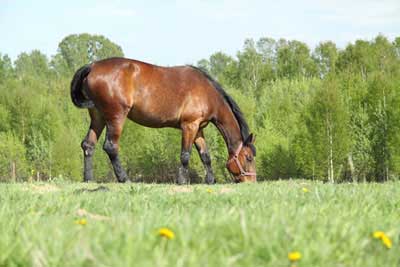Pasture Management Within An Effective Parasite Control Program

Written by Preston Hickman, DVM, Wichita Equine and Sports Medicine
Horses by nature are free roaming animals and used to being able to graze 24 hours per day. This has made for many adaptations by both the parasites that afflict horses, and the animal’s ability to avoid parasitism. Pasture management is an important aspect of animal husbandry that deserves careful consideration. There are several things that effect pasture management and parasitism including: stocking rate, cross-grazing, grazing frequency, parasite resistance, parasite lifecycle and pasture grooming. Time of year also influences egg shedding by adult parasites within the animals system and accounts for the use of the strategic rotational deworming strategies found in many of the yearly packages.
Stocking rates on normal pasture for horses should not exceed one animal per two acres. This is not possible in most situations given the environment in which most horses live now days, therefore, many people use alternatives in order to provide adequate forage in a limited space. An important aspect that is often overlooked however is parasite lifecycle and the ability of the horse to avoid parasitism by selective grazing. Another important aspect would be to graze animals after the dew has lifted, by doing this we have the ability to slow down the amount of contamination since, infective larva are contained within the moisture droplets on the vegetation. Timed turn out and the use of paddock lock up on full-time pasture horses can be valuable in lowering metabolic issues such as insulin resistance and disease conditions such as metabolic syndrome or laminitis.
A cross grazing program is a viable option if you have the availability of a different species to graze on the same pasture. For example; using cattle to graze behind horses and vice versa; takes the advantage of the fact that each species has specific genera of parasites that is not communicable to the other. This strategy helps to lower the numbers of infective stage larva to each species being utilized in the cross grazing program. Cross grazing also increases the ability to manage the pasture grass length and weed control. Cross grazing with cattle would also change the grass length since cattle graze by wrapping their tongues around the grass and pulling it rather than clipping it like sheep and horses do. This method might be important if you have the space and your pastures are relatively clean. In contrast sheep would be a good cross-grazing species if one has many woody plants or weeds that horses and cattle might not desire to eat. Both of these management strategies take into account the ability of the grass to rejuvenate itself while being continuously grazed.
Vacuuming and not harrowing is the latest option to eliminate fecal material on pasture without causing further contamination or burden to the forage. It effectively eliminates the source and achieves superior results to other options such as mowing and harrowing alone. Infective parasite larvae and grass stress are both decreased due to fecal material being eliminated from the pasture. It further eliminates the need to remove animals from pastures for long periods of time to allow infective stage larvae to die before grazing is once again resumed. This method in conjunction with cross- grazing and an effective strategic deworming plan is proven to be the best practice to date for pasture management. When we look at pasture management it is important for us to consider where we have the option to change in order to maintain the most effective parasite control while still achieving adequate turnout time for the horse. Spreading fecal material from stalls and runs on pastures that are being currently grazed by horses should be eliminated and composting manure should be employed for the safety and longevity of the horse.
About the author:
Dr. Preston Hickman practices veterinary medicine in Wichita, Kansas, specializing in equine podiatry and sports medicine. He combines traditional veterinary medicine with video gait analysis to diagnose physical problems and abnormal motion in horses. His experience as a farrier and chiropractor allow him unique perspective into biomechanical movement. Dr. Hickman has worked extensively with horse wellness issues as Assistant Medical Director for the Louisiana Racing Commission, overseeing four tracks and 16 veterinarians. Dr. Hickman has a background in mixed practice, equine and bovine veterinary medicine, as well as veterinary consultation to feedlots.


